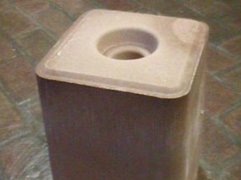Week 6
Feed Processing |
 |
 |
Feed Processing for Rumiants
Instructions for listening to audio clips
- Download the QuickTime
Player to listen to the audio files.
- Read the QuickTime
Instructions for installation help.
- Download the RealPlayer to listen to the audio files
- Instructions are on the RealPlayer download page
Text Transcript
Follow along with the audio...
Follow along with the audio...
Beef Cattle
- Grain processing – mostly for feedlot cattle
- Some processing will improve intake, efficiency
- Coarse grinding enough, some improved starch digestion with heat
treatment
- See Table 11-7 on page 212 for details of comparisons
- As forage increases, processing advantage decreases
- Forage processing
- Mostly to improve handling, mixing, delivery
- Slightly faster forage passage rate, higher intake
- Cubed forages not economical, too large for young beef
- Pelleted feeds can reduce waste when feeding on the ground, allow other supplementation (mineral/vitamins, protein) in one feed
- Supplements can be pressed into large blocks
- Regulate intake, reduce labor of supplementation

Dairy Cattle
- Grain processing important
- High nutrient requirements
- Must balance rapid digestibility with acetate in rumen for milkfat
production, reduced acidosis
- Course grinding, dry rolling adequate for TMR feeding
- “Textured” feeds of pellets and rolled or flaked grains best for separate
feeding of grain as in milking parlor
- Some forage chopped for mixing and handling convenience
- Table 11-9 on page 214 summarizes dairy feeding trials
Sheep & Goats
- Limited processing required, fast-growing lambs only
- Pellets can limit ground feeding waste, increase forage intake
- Dairy goats can receive dairy parlor grain
|

